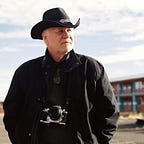The Fascinating Painted Buildings of Gray Mountain, Arizona
A part of the “Painted Desert Project," they stand in contrast to the high desert surrounding them.
One of my favorite places in the world is the Navajo Reservation in northern Arizona.
I feel at peace there. From Kayenta to the Vermillion Cliffs, so many places give me such warm feelings and vague memories.
This is a land that reminds us of the slowness of time, the deliberateness of time. We see it on weathered cliffsides, looking nearly untouched after millennia.
We find it in the sky, the canyons, and the resilience of the people who live on this magical part of the world.
There are many abandoned buildings on the Res. And they sit in testament to the changing world.
While made by man, their slow decay is, in some ways, similar to the surroundings they inhabit.
“The Painted Desert Project” is focused on using those remnants of human endeavors as a canvas for artists to work on.
Here is some information on the Painted Desert Project:
The Painted Desert Project is a privately funded public art initiative that connects artists with communities through mural opportunities on the Navajo Nation. It was started in 2012 by Chip Thomas, a doctor, photographer, and activist who has been a long-time resident of the reservation. The project began with Thomas inviting world-renowned street artists to the Navajo Nation for short-term residencies, during which the artists immersed themselves in the local communities. The art, primarily murals and enlarged photographs, can be found on water tanks, buildings, and roadside stands adjacent to the interstate highways in northwestern Arizona. The installation of art pieces has encouraged the revival of previously abandoned buildings and roadside stands, thereby energizing the community and elevating economic prospects on the Navajo Nation. The project aims to boost tourism on the reservation, supplement the incomes of families with roadside stands, and nurture the creative talent of local youth.
— Perplexity
I am planning a project to shoot as many of these installations as I can this summer. They change constantly, so the project would be a snapshot of a moment in time where the reservation had a specific set of art.
I’m allowing two weeks, so I will have to work fast.
I once used them to make a portrait of a friend and model who was traveling with the group as we headed up to Zion.
The Anasazi Hotel sits directly next to the painted tanks.
It had fallen into disrepair, and when I saw it the first time it looked like this:
Today, it is a tapestry of painted icons. Eyes watch everything that comes and goes, and the effect is eerily distracting.
We felt a presence there when we were shooting, so we made our images and moved on.
One of the exceptional forms of art you will find is huge photographic prints. The clarity of the photography against the textured and often decaying walls is something truly unique.
A large photograph is pasted over the window of a small building. Mixing the natural graffiti with the crisp photography is a dazzling juxtaposition.
It can be both jarring and thrilling to see these images so out of context, yet they create a new context for the installations.
The photography I have seen is exceptionally well done, and the documentary style, so lifelike and large, creates a dynamic juxtaposition of color, dimension, and time.
The brilliant colors can be seen for miles, and the detailed art is truly fun to explore. So many designs blended with the three-dimensional building can make a photographer grin with anticipation of what may be found.
There are other examples of the Painted Desert Project nearby. This abandoned storefront sits along the highway and has received a new look courtesy of one of the artists in residence there.
(Music is an excerpt from my Sonata for Viola, “Coconino”)
My favorite road in the west, and I have ridden most of the roads out here, are 89 and 89A.
The road begins in Ajo, Arizona, and makes its way all the way north to the Canadian border, just a little way east of Glacier National Park.
One of my planned rides for this summer is to take 89 from its beginnings to the end and document the whole thing for a project.
Here’s a map. If you ever have the chance to take 89 from Flagstaff to Page (or Kanab through Jacob’s Lake), you will fall in love with it as I have.
See ya next time.
Hi, I’m Don Giannatti, a photographer and mentor for up-and-coming photographers. You can find me on my website, Don Giannatti, and at my Substack site, where I also publish for creative people. All subscribers to my Substack have access to a free, long-form workshop on the business of commercial and professional photography.
